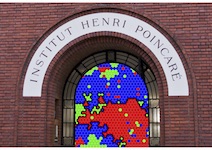|
|
|
Speakers & Program— Andrei BERNEVIG (Princeton Univ.): "Topological Matter". — Tomaž PROSEN (Lujbjana Univ.) : "Many-body quantum chaos and random matrix theory". One of the key goals of quantum chaos is to establish a clean relationship between the observed universal spectral fluctuations of simple quantum systems and random matrix theory. For single particle systems with fully chaotic classical counterparts, the problem has been essentially solved by M. V. Berry within the so-called diagonal approximation of semiclassical periodic-orbit sums. — Adam NAHUM (Oxford Univ.) : "Entanglement and information spreading". For many purposes, a nonzero temperature makes the dynamics of nonintegrable quantum many-body systems effectively classical. For example, the effective coarse-grained description of local correlation functions is typically some form of classical hydrodynamics. In this short course I will discuss the dynamics of 'nonlocal' quantum observables that cannot be described with conventional hydrodynamics. These include the entanglement entropy and other observables which characterise the spreading of quantum information after a quantum quench. I will describe simple many-body systems, random unitary circuits, that allow calculations via exact mappings to archetypal classical statistical mechanics problems: directed polymers, membranes, growing clusters, etcetera. I will use these mappings to motivate a more general phenomenology of information spreading in chaotic systems. — Gregory SCHEHR (CNRS & LPTMS, Orsay Univ.) : "Growth processes and integrability". Stochastic growth models in the Kardar-Parisi-Zhang (KPZ) universality class are cornerstones of non-equilibrium statistical physics. As such, they have been extensively studied, both in theoretical physics as well as in mathematics. In these lectures, I will review the spectacular progresses that have been achieved, during the last twenty years, for the KPZ universality class in 1+1 dimensions. — Jean-Marie STEPHAN (CNRS & Univ. Lyon 1) : "Extreme boundary conditions and random tilings". Standard statistical mechanical or condensed matter arguments tell us that bulk properties of a physical system do not depend too much on boundary conditions. Random tilings of large regions provide counterexamples to such intuition, as illustrated by the famous 'arctic circle theorem' for domino tilings in two dimensions. — Jorge KUCHAN (CNRS & LPENS) : "Probability distribution and correlations of matrix elements of operators in chaotic systems: completing ETH". — Fabian ESSLER (Oxford Univ.) : "Non-equilibrium dynamics in split one-dimensional Bose gases". — Benoit DOUÇOT (CNRS & LPTHE) : "The Floquet spectrum of superconducting multiterminal quantum dots". |


